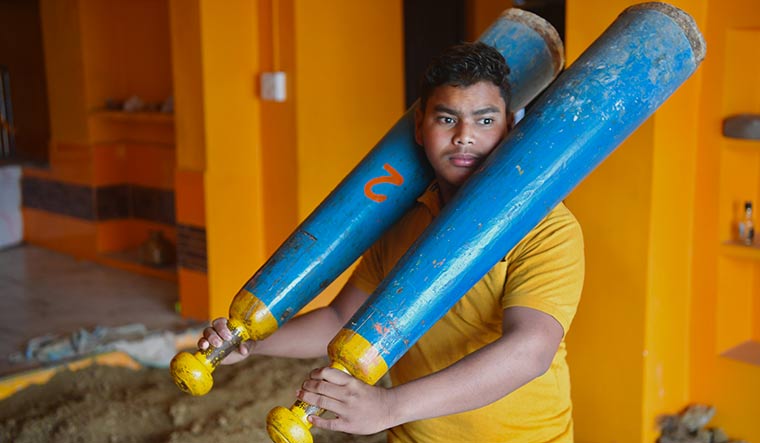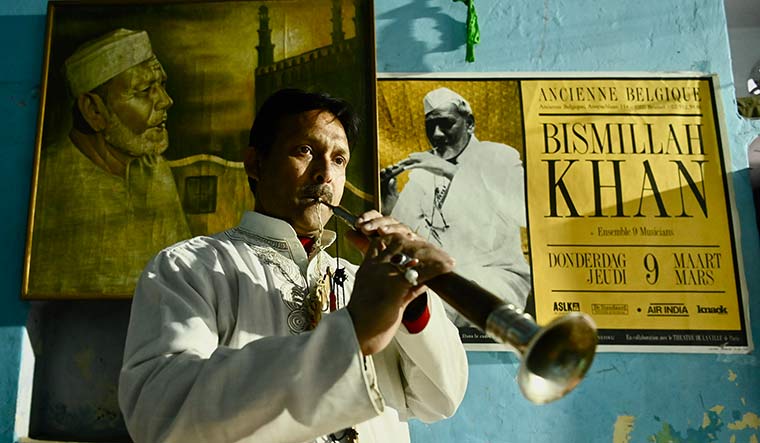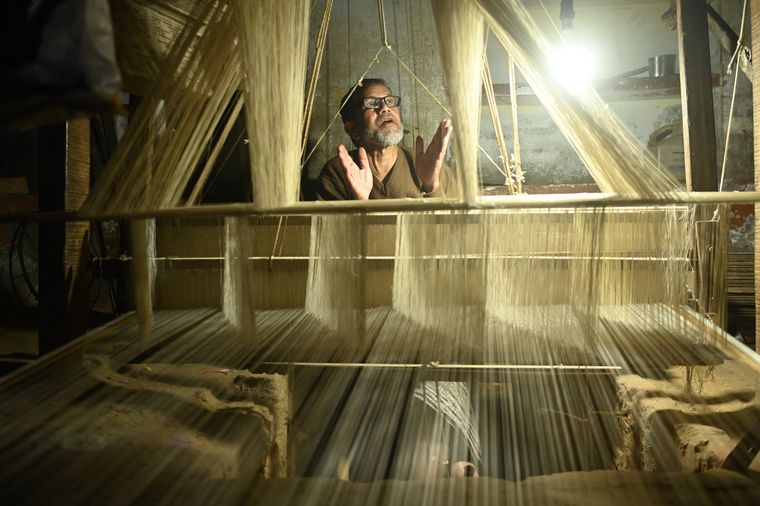IN THE CITY of Varanasi, Year 2024 will see a ‘king’ being formally anointed, well before the Lok Sabha elections. To venture into his territory, we followed a procession along a narrow lane towards the river Ganga. Chants of ‘Ram naam Satya hai’ filled the air, which smelled of smoke and burning flesh, and of pakoras and jalebis being deep-fried on a slope leading to Manikarnika Ghat.
On a corner of a concrete deck overlooking the water and a dozen burning pyres on the ghat, there sat the baby-faced Om Harinarayan Chaudhary, the future king. All of 16, he wore a traditional ponytail, with T-shirt and jeans and slipped into his sneakers and a yellow jacket after finishing his work. We asked him about the nature of his work. He instantly replied, “Hum gaddi sambhalte hain, bhaiyya (I manage the throne, brother).” He is already referred to as Dom Raja, the king of cremations, a hereditary title thrust upon him after his father’s death two years ago.
Elsewhere, the race for another gaddi has intensified. Winning in Varanasi is a matter of political life and death for the BJP campaigners in the elections to the Uttar Pradesh legislative assembly. They are leaving nothing to chance in the five assembly segments of Prime Minister Narendra Modi’s parliamentary constituency--Varanasi North, Varanasi South, Varanasi Cantonment, Sevapuri and Rohaniya.
Om Harinarayan has only admiration for Modi. “He changed the status of our community,” said the boy. “We are now treated with respect because of him.”
Manikarnika is the busier of the two cremation ghats in Varanasi. Pyres burn here day and night, the fire tended by people of the Dom caste. The belief is that the dead attain salvation after the pyre is lit by a Dom. Like other dalits, the Dom were untouchables, whether rich or poor. Om Harinarayan’s ancestors have been Dom kings for centuries. His father, Jagdish Chaudhary, who died at age 55, was one of the proposers of Modi’s candidature in the 2019 Lok Sabha election. He was conferred a Padma Shri after his death. Om will be crowned Dom Raja when he turns 18.
The palace of the Dom Raja is situated near Man Mandir Ghat. Om is home-schooled, has an akhada (gymnasium) at home and is physically protected by an ever-present retinue. There are 40 Doms working under Om. “I wanted to be a doctor, but now this is my destiny. I will work for the welfare of my people,” he said. In his balcony, two sculpted tigers guarded the wall facing the river.
Another dalit community populates the fringes of Chitrasenpur on the outskirts of the city. We reached there after a short drive through green mustard fields and saw an almost lifeless form, a teenage girl, lying on a bed-sheet on open ground. “The doctor said she is badly infected; it is the water,” said a local woman. On another corner, a girl sat scrubbing utensils with mud and trash.
It is a settlement of some 30 huts made of mud or old clothes. These are home to the Musahar, one of the poorest dalit castes. There is no toilet in any of the houses. “We wait for the night and go to the fields,” said Susheela, a woman Musahar. “If it is day, the farm owners will beat us up.”
Musahar men and women work in mustard fields and brick kilns, bearing the burns of untouchability.
“I dreamt a lot about a good life, a house and education for my children,” said Sheela, a young Musahar mother. “But how will we progress if nobody even wants to touch us? No one from the village invites us to their functions. When we go to market, the shopkeepers place our groceries far away. In school, our children are called dirty. So they drop out.”
The NGO Muheem has been teaching the children and women, and telling them about healthy habits. But the challenges are heavy, said Swathi Singh, co-founder of the NGO. “We interviewed a dozen dalit teachers and none of them was ready to come and teach the Musahar. Their situation is so bad that no one wants to be associated with them or help them.”
The Musahar women said they did not know about any welfare schemes, or about their elected representatives, or even about voting.
As we returned to the city, the streets seemed sombre, bereft of political activity. The election commission had banned rallies, to restrict the pandemic. Not even party flags and posters were visible. But in the cold mornings, the many tea stalls in the city warmed with poll talk. The iconic Pappu Chaiwalla’s stall near Assi Ghat is a favourite of journalists. The shop was started by a World War II veteran. His son, Pappu or Vishwanath Singh, spread its fame over the decades, and it was chosen for one of the Chai pe Charcha events organised by the BJP in 2014. Even with such fame, the shop does not have a name board or proper seating.
A retired professor of Banaras Hindu University, Rajendra Prasad Singh, sat there sipping his third glass of tea in the company of traders, office workers and a judge. Occasionally thumping the table and letting the tea glass balance itself, he spoke passionately about why BJP deserved to win: crime control, smooth electricity supply, better roads and newer bridges... The tea lovers asserted that inflation was not an issue.
Pappu’s son Manoj, who now runs the shop, voiced disagreement. As the tea lovers shouted him down, he went back to his work, without another word. Customer is king.
Like the tea lovers, many boatmen of the Ganga and the local journalists said the BJP would benefit from the Kashi Vishwanath temple corridor project. A newly built pathway under the project allows pilgrims to reach the temple from the riverfront, instead of struggling through narrow lanes on the other side. Escalators, an art gallery, a museum, a Vedic centre and a new home for the terminally ill will come up. More than 300 houses have gone down. The administration says 1,400 displaced people were rehabilitated.
A former mahant of the temple, Kulpati Tiwari, said his family was displaced. “A part of me has died,” he said. “Nowadays I only feel sadness. Kashi is finished.” He said the project was against vastu principles and disturbed the holy ecosystem. “Forty-five temples, big and small, have been affected; there will be repercussions.”
Strolling around Meer Ghat, we chanced upon Akaash Upadhyay, an aspiring filmmaker and actor, who led us to the little known Dharma Koop. In olden days, sick people went to this well and peered into it for prognosis. If they could see their faces reflected in the water, recovery was at hand; if not, death would catch up. Do people still consult Dr Well? Only the plucky do so. The water level has dipped to such an extent that the outcome is same for everyone.
Akaash has made a film on the Kashi Vishwanath corridor hoping to hawk it at international film festivals. Talking about some of the old buildings, he took us to a widow home adjoining the corridor which escaped acquisition. Every inch of its walls was inscribed with prayers and other outpourings of piety. There was, however, no dearth of once-stubborn tenants in the area now happy with the hefty compensation from the government.
One of our mornings was devoted to the mahant of the Sankat Mochan temple, Vishwambhar Nath Mishra, who is a professor at IIT Varanasi. While we watched him take his ritual bath in the icy river, a half-naked young man on the steps boomed: “Koi bhi nahi bana jo Kumbhakaran ko maar sake (No one can kill Kumbhakarna).” He concluded it with a terrifying layer of laughter. As soon as the professor emerged from the river, the young man gave a more intense performance and touched his feet. Apparently his wife had forbidden him to play the demon prince on stage, so he chose the riverfront as his proscenium for a daily dramatic peformance.
“The faecal value of the water is very high,” said the professor after the dip. He cited water quality data to support his statement. Discussing the Kashi Vishwanath corridor project, he said that making changes to the ghats would have a devastating ecological impact. “They have created a new platform by obstructing the river flow. Banaras is going to face the consequences of that. In the past flood, places near Rajghat were destroyed. It is going to be worse in the coming years. The Ganga ji in Banaras is crescent shaped and it is presumed that the shape [represents] Chandrama. That shape is going to be spoiled now.”
Mishra lives on Tulsi Ghat, where the poet Tulsidas wrote Ramcharitmanas in the 16th century. He indicated a room in his house where the poet lived before being banished from Varanasi.
There are 84 ghats in Varanasi, each with its own character, colour and contour. At Assi Ghat, fine arts students from BHU were sketching and painting. Dashashwamedh Ghat enthrals everyone with the Ganga aarti every evening. On Darbhanga Ghat one can see an architectural marvel, a fort turned into a hotel.
Balaji Ghat is testimony to the harmonious coexistence of multiple cultures of Varanasi. It was at the Mangala Gouri temple on this ghat that Ustad Bismillah Khan, the shehnai maestro, did his riaz. Searching for his house in a maze is an adventure in itself. Leaving our car a few hundred metres away, we walked through the dense Harha Sarai market and a web of narrow lanes that led to a light purple door. To knock on the door, one had to climb a few steps.
Nasir Abbas, a grandson of the maestro, occupies the house with two dozen family members. “We still get random knocks on our door. Visitors bow, cry and leave, remembering my grandfather,” he said.
The house has several rooms in irregular patterns, but it is on the terrace that Bismillah Khan lived. “I still remember my grandfather practising in the mornings, sending passersby into a trance,” Nasir said. He picked up the shehnai, the only one that has passed down generations, from the maestro’s room and played ‘todi’, a morning raag.
Also read
- 'BJP scores big': Election results so far in Goa, Punjab, UP and Uttarakhand
- UP polls: Akhilesh Yadav's solo fight to recapture Lucknow
- Akhilesh Yadav interview: I have learnt how to defeat the BJP
- Dalit identity has become more assertive, but Mayawati has moved at a snail's pace
- Manifestos are fake; we do what we say: BSP’s Satish Chandra Misra
- No samajwad in Samajwadi Party: Aparna Yadav, BJP
Nasir is a claimant to the musical legacy and was in his grandfather’s troupe for a decade. He has his own troupe now, but bookings are inadequate. “Everything was fine till my grandfather’s death. After that we started struggling financially. I really hope the government gives us some financial help.” The house also faces an existential threat due to differences in the family. “We want the government to protect it and turn it into a heritage site,” he said.
In 2014 he refused to endorse Modi. In the next election he offered support, but got no response. “Modi is doing great work. I hope he gives us an opportunity to be associated with him,” he said. “In 2014 some people brainwashed us and we went against him. We wish to change that.”
Rishi Jingran, a publisher, talked of a brainwash in his younger days. He said he had attended shakhas of the RSS, and worked in its student wing and later in the ruling party’s IT cell. He even deleted all his Muslim friends from his Facebook account.
Today, Rishi, 38, is working to defeat the BJP. It had ceased to be the party he wanted to be in, he said. He now targets the Bajrang Dal. So what happened to his Muslim friends? “I added them back,” he said. “Why should I lose friends?”
A Muslim wedding was being celebrated at the Bajardiha area, which makes some of the finest Banarasi silk saris. Men and women sat under a shamiana in the bridal house. A few metres away is the house of Jameel, a weaver with blue eyes. Like many others in the locality, he has a loom in his room. He is one of the few who do not use power looms. He propelled the shuttle with his hands, marrying the warp to the weft. Working 12 hours a day, Jameel, 50, can make a sari in two weeks.
“This work is a family tradition,” he said. He learnt it from his father and grandfather. It is their art. “I have taught it to my children,” he said, “but I am not sure they wish to do it.”
Power loom weavers here forced the government to roll back a change in the electricity billing system in 2020. One of the weavers, Gulzar, said power tariff was still a poll issue. “We want subsidies, otherwise we are doomed,” he said. “The Samajwadi Party has promised it.”
The winter has brought migratory birds and Malaiyo sweets to Varanasi. Polls may come and polls may go, but the river will go on. For ever? Ecologists may not agree.





